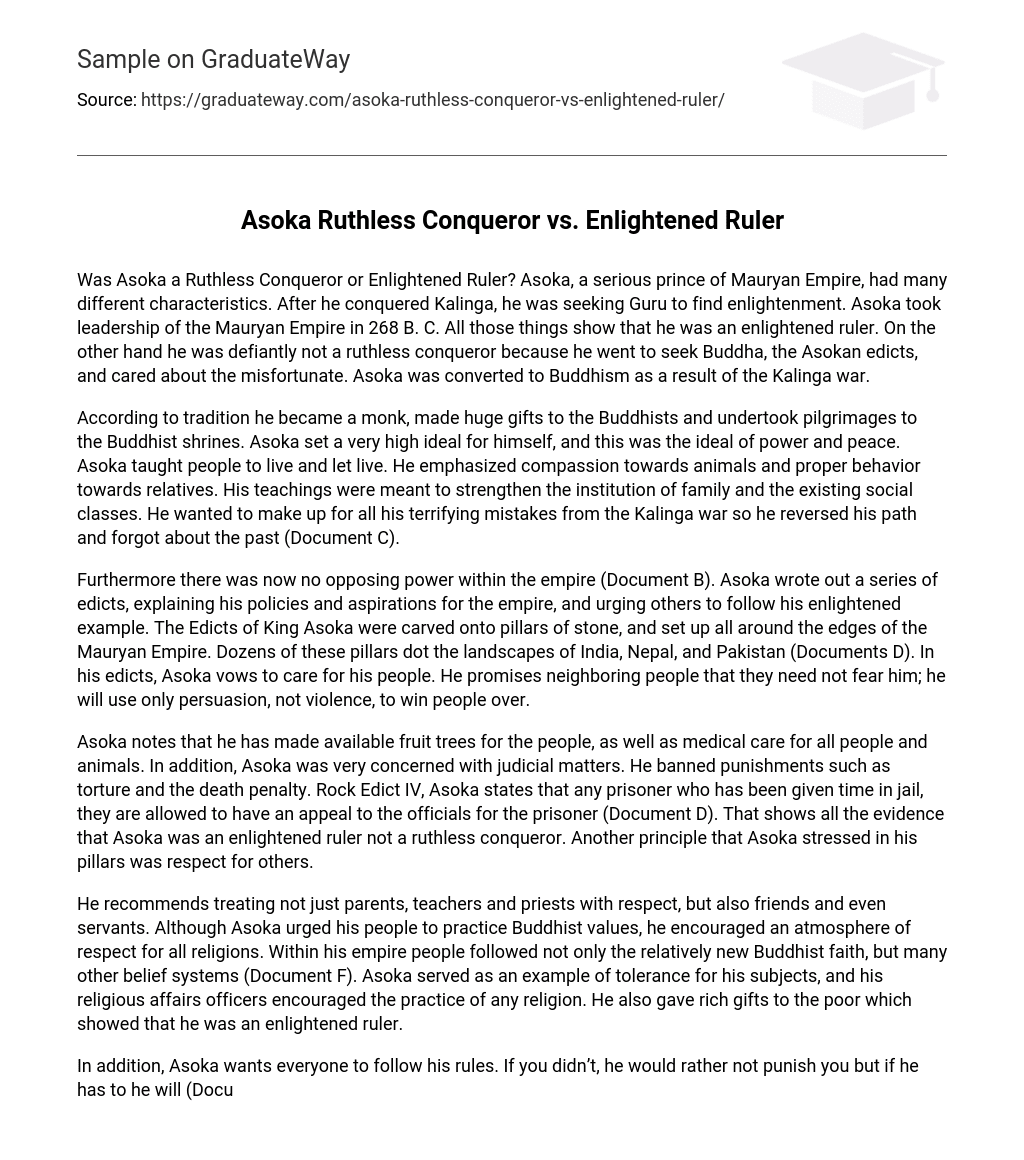Was Asoka a Ruthless Conqueror or Enlightened Ruler? Asoka, a serious prince of Mauryan Empire, had many different characteristics. After he conquered Kalinga, he was seeking Guru to find enlightenment. Asoka took leadership of the Mauryan Empire in 268 B. C. All those things show that he was an enlightened ruler. On the other hand he was defiantly not a ruthless conqueror because he went to seek Buddha, the Asokan edicts, and cared about the misfortunate. Asoka was converted to Buddhism as a result of the Kalinga war.
According to tradition he became a monk, made huge gifts to the Buddhists and undertook pilgrimages to the Buddhist shrines. Asoka set a very high ideal for himself, and this was the ideal of power and peace. Asoka taught people to live and let live. He emphasized compassion towards animals and proper behavior towards relatives. His teachings were meant to strengthen the institution of family and the existing social classes. He wanted to make up for all his terrifying mistakes from the Kalinga war so he reversed his path and forgot about the past (Document C).
Furthermore there was now no opposing power within the empire (Document B). Asoka wrote out a series of edicts, explaining his policies and aspirations for the empire, and urging others to follow his enlightened example. The Edicts of King Asoka were carved onto pillars of stone, and set up all around the edges of the Mauryan Empire. Dozens of these pillars dot the landscapes of India, Nepal, and Pakistan (Documents D). In his edicts, Asoka vows to care for his people. He promises neighboring people that they need not fear him; he will use only persuasion, not violence, to win people over.
Asoka notes that he has made available fruit trees for the people, as well as medical care for all people and animals. In addition, Asoka was very concerned with judicial matters. He banned punishments such as torture and the death penalty. Rock Edict IV, Asoka states that any prisoner who has been given time in jail, they are allowed to have an appeal to the officials for the prisoner (Document D). That shows all the evidence that Asoka was an enlightened ruler not a ruthless conqueror. Another principle that Asoka stressed in his pillars was respect for others.
He recommends treating not just parents, teachers and priests with respect, but also friends and even servants. Although Asoka urged his people to practice Buddhist values, he encouraged an atmosphere of respect for all religions. Within his empire people followed not only the relatively new Buddhist faith, but many other belief systems (Document F). Asoka served as an example of tolerance for his subjects, and his religious affairs officers encouraged the practice of any religion. He also gave rich gifts to the poor which showed that he was an enlightened ruler.
In addition, Asoka wants everyone to follow his rules. If you didn’t, he would rather not punish you but if he has to he will (Document E). Emperor Asoka was also an able ruler, expanding trade, undertaking public works, encouraging arts and establishing institutions that worked for the welfare of his people. At first, he killed millions of people to get to the throne which changed the lives of a plethora of people. Then, he changed for the good with helping others seek Buddha. From an aggressive ruler, Asoka had become a man with a conscience, and now, is considered an enlightened ruler.





